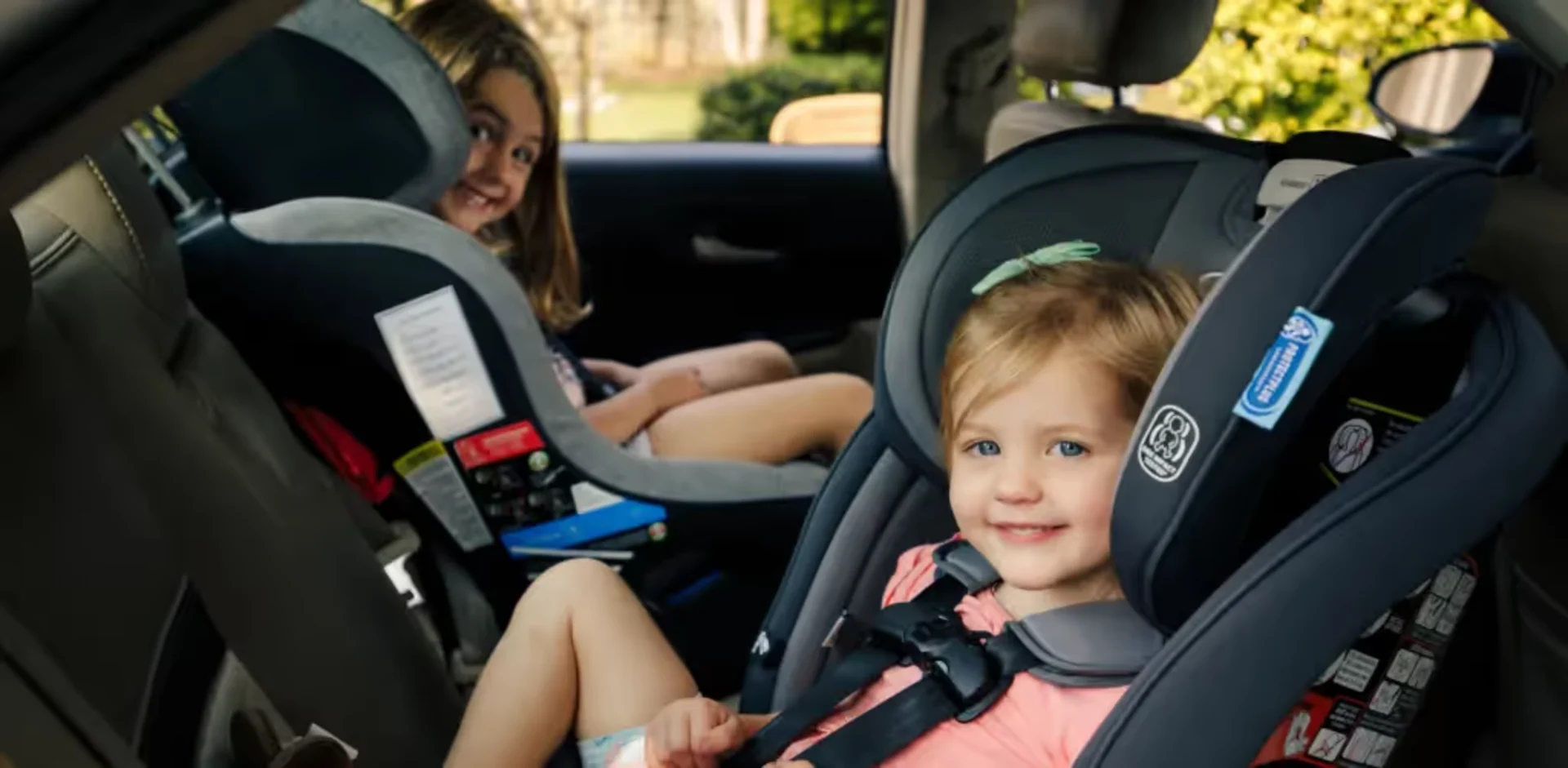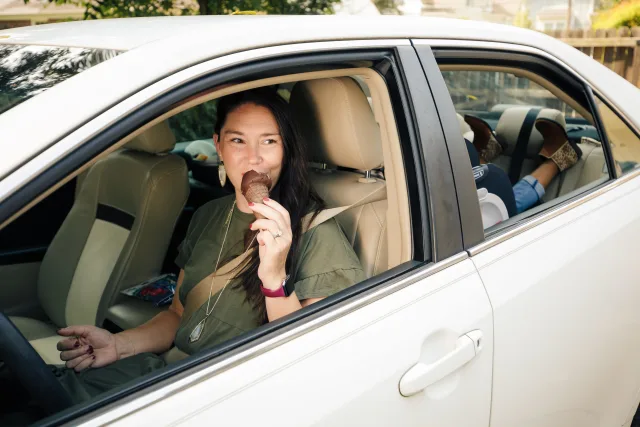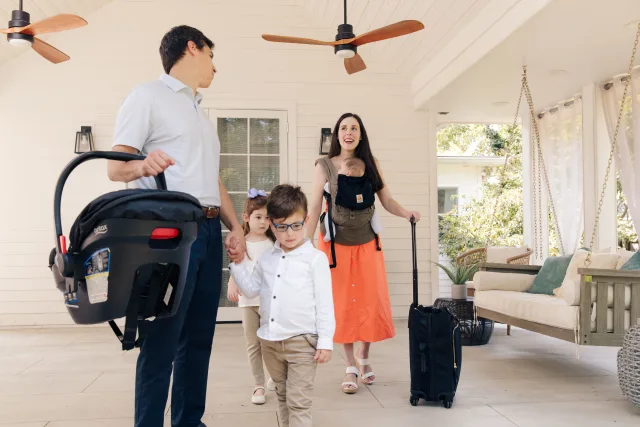Before you became a parent, terms like “rear-facing” and “forward-facing” were probably foreign to you. But now that you have a kid or two of your own, you are well aware of the many debates about car seat safety. You know….the ones all over the Facebook mom groups and parenting forums. When do you switch them? What works best? What’s legal and what’s not? And then, what are the best forward-facing car seats?
There’s so much conflicting information from people who are not experts. And we all know you can’t trust everything you read online. Especially things you read on social media. So, how do we know what’s safest for our kiddos?
Today, we’re dedicating our post to rear vs forward-facing to answer this question. In fact, Safe in the Seat was founded specifically for this reason: helping you sort through the myths and false information to find the truth. We aim to be the one-stop shop for all of your car seat safety questions and more. So, let’s get into it! What’s the deal with rear-facing and forward-facing?
Rear Facing vs Forward Facing
Rear Facing Car Seats
First up, we have rear-facing car seats. These are infant car seats or convertible seats that face the back of the car. All kiddos start out facing this direction. The rear-facing positioning is important for babies whose spinal cord hasn’t yet ossified (turned from cartilage to bone). They need more support of the head, neck, and spine to protect their delicate bodies.
In the event of a crash, a rear-facing car seat protects a baby’s whole body by absorbing the crash impact. The seat hugs and supports every part of your baby, rather than just the seat belt contact points. This is crucial for the safety of your child in a collision!
How Long Should a Child be Rear Facing?
How long should a child be rear facing? When asking this question, there are two things that must be considered: What are the child car seat laws in your area? And, what is recommended? We know that not every state requires motorcycle riders to wear a helmet, but we also know that it’s much safer if you do! So, what’s legally required isn’t the only thing to consider.
Every state has child passenger safety laws, and many of those require kids under the age of two to be in rear-facing car seats. But, the National Highway Traffic and Safety Administration, the American Academy of Pediatrics, and we at Safe in the Seat recommend staying rear-facing for as long as possible.
View this post on Instagram
A post shared by Michelle Pratt, CPST (@safeintheseat)
Weight Limit for Rear Facing Car Seat
You’ll know when they’re ready to stop rear facing once they’ve hit the top height or weight limit, according to the car seat user manual straight from the car seat manufacturer. Most convertible car seats accommodate rear-facing up to 40 or 50 lbs. Meaning, most kids can stay rear-facing until about 4 years old in the right car seat. Don’t be too eager to flip your kiddos around.
Forward Facing Car Seats
Front-facing car seats are car seats that face the front of the vehicle. Like the rear-facing position, they still utilize the same five-point harness to distribute crash forces across the strongest points of a developing body.
Forward-facing car seat restraint systems protect the contact points of the belts much like a standard seat belt. This means body parts outside those belts aren’t supported, including the head. In a collision, injury to the head, neck, and spine are more likely in a front-facing seat. Especially when it comes to young children who shouldn’t be positioned this way yet.
Car seats facing the front of the vehicle provide great protection to kids of the appropriate age. They’re for children who have reached the max weight or height limits on the rear-facing mode, but have not yet reached the maximum limits on the front-facing side. Kids will stay in a front-facing seat with a five-point harness until 5-7 years old.
Forward Facing Car Seat Requirements
If you’ve been reading our posts for a while and have a child in a rear-facing seat, you might be well-versed on how to safely use your car seat. But, when you switch to front-facing, some requirements change and there are a few new features to learn about. Here are those changes:
Headrests:
Unlike when the car seat was rear-facing, the vehicle headrests now matter for a proper car seat fit. Read your vehicle and car seat manuals to confirm the correct installation with your headrests.
Recline:
When a car seat switches to front facing, the safe recline angle changes. Usually, car seats have pretty clear indicators that show you where the seat should recline based on direction. But, if you’re confused, read the manual. (You’ll hear us repeat that a lot. That manual is key!)
Belt Path Install:
There are two ways to install most harnessed car seats. You can use the vehicle’s seat anchors or the seat belt. But did you know the anchors have a weight limit? It’s true! Double-check the max weight in your car seat’s manual and switch to a vehicle seatbelt install once that weight has been reached.
Tether:
To reduce forward movement of the forward-facing seat, all North American harnessed car seats have a top tether that connects to a designated anchor in the vehicle. This is critical! This is a must-use safety feature to lower the risk of head injury, but many people forget because they don’t use it when rear facing.
View this post on Instagram
A post shared by Michelle | Car Seat Safety (@safeintheseat)
Straps:
When your child was rear-facing, their straps had to be below the shoulders, now they need to be just above. Additionally, your seat may have specific rules for crotch buckle placement that change with your child’s direction.

Checking over these changes and reading your manual will help you get a safe and secure fit in your forward-facing car seat. Safety is still a high priority, and car seats function differently in every stage of the journey! Reviewing your car seat manual each time you use a new mode is a great idea.
View this post on Instagram
A post shared by Michelle Pratt, CPST (@safeintheseat)
Why is Rear Facing Safer?
Rear-facing is the safer option. During the most severe types of collisions — frontal and side impacts — a rear-facing child is cradled by the shell of their car seat, keeping their head, neck, and spine in alignment. When forward facing, the shoulders, neck, and head are thrown forward due to tremendous crash forces that can cause severe injury and even death. It doesn’t take much force to cause devastating injury to a developing body, and rear-facing allows the car seat to absorb more force away from the child. In fact, survival is increased significantly when a child is properly rear facing.
As we explained, young children do not have a developed spine to withstand the enormous forces involved in a car crash. Front-facing car seats only support the belt’s points of contact and don’t prevent the dangerous whiplash experienced by the rest of the body. You can see what we mean in this video!
Rear-facing children receive protection from all three types of collisions.
The car seat helps absorb and dissipate the force of the car colliding with the object. Then, your child is gently cradled inside their car seat as their body moves forward into the vehicle seat in front of them, preventing human collision with other objects. And lastly, collisions in rear-facing car seats put less pressure on the organs, which are experiencing a final, internal collision all of their own.
If you’re worried about your child’s legs bent inside or outside a rear-facing car seat due to their size, don’t fret! This is no problem at all, and leg injuries are actually more likely in a front-facing crash — just like the rest of their body, a forward-facing child’s legs will be thrown forward so forcefully that they can be injured when they hit the back of the front seat or other vehicle surfaces. So, next time another parent says their child doesn’t “fit” rear-facing because of their long legs, kindly remind them that legs hanging over the sides or criss-cross-applesauce are perfectly safe. Rear-facing is still best!
There’s a time and place for rear-facing and forward-facing car seats. But staying rear-facing as long as possible is best for kiddos within the height and weight requirements!
In conclusion, facing the back of the vehicle instead of the front provides unmatched protection for your littles. Rear-facing car seats are designed to support developing bodies in even the most extreme accidents. So, you should have your child rear-facing as long as possible. Children should rear face until they’ve reached the height or weight limit on the car seat. (Which is usually about to age 4). You won’t regret this decision now that you know it provides the highest level of protection possible for your most precious cargo.
Your car seat journey is a long one. From birth to about 12 years old, your child will be safely snug in their designated car seat and booster seat. Each type of car seat and car seat position has its time and place, including front-facing seats! But, moving to a front-facing car seat too early can seriously undermine the safety of your child in the event of even a minor crash. Just knowing your kiddo is as safe as can be will give you much-needed peace of mind.
Infant Course
In this sample lesson from our Infant Course, you will learn why car seats and their proper use are so critical to keeping kids safe. Want to learn how to keep your child safe on every ride? Check out our Infant Course or Convertible Course on the how-tos of installation, harnessing, and troubleshooting.
We want you to have confidence in ALL your car seat choices, so head over to our website to learn more about all things car seat safety. There’s a lot to know, but between our blog and Instagram, we know you’ll find all the information you need. But, if you don’t, we also offer car seat courses and consultations with our child passenger safety technicians to give you all the instructions you need to stay safe in the seat. Together, we can keep your kiddos protected!






